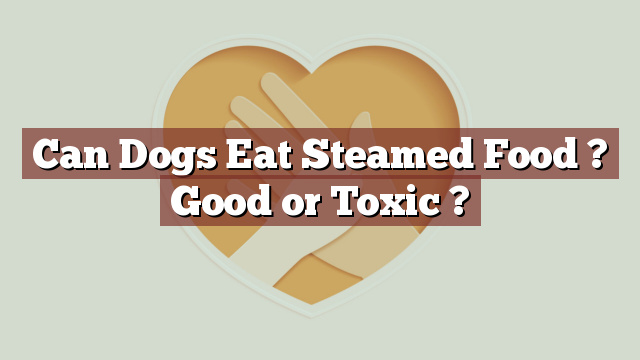Can Dogs Eat Steamed Food? Good or Toxic?
When it comes to our beloved canine companions, it is crucial to ensure their diet consists of safe and nutritious foods. As responsible pet owners, we must be knowledgeable about what foods are suitable for our dogs and what may pose a risk to their health. One common question that arises is whether dogs can eat steamed food. In this article, we will explore the nutritional value of steamed food for dogs, evaluate its safety and toxicity, discuss potential risks and benefits, and provide guidance on what to do if your dog consumes steamed food.
Nutritional Value of Steamed Food for Dogs: What Does it Offer?
Steaming is a cooking method that is often preferred due to its ability to retain the nutritional value of food. Steamed food, whether it is vegetables or meat, can be a valuable addition to a dog’s diet. Vegetables such as broccoli, carrots, and green beans retain their vitamins, minerals, and fiber when steamed. Similarly, steamed chicken or fish can provide lean protein, essential amino acids, and omega-3 fatty acids. The gentle cooking process of steaming can help preserve these beneficial nutrients, making them more easily digestible and absorbable for our furry friends.
Can Dogs Eat Steamed Food? Evaluating Safety and Toxicity.
Yes, dogs can eat steamed food as long as it is prepared properly and does not contain any harmful ingredients. However, it is important to note that not all types of steamed food are safe for dogs. Some foods can be toxic to dogs, even in their steamed form. For example, certain vegetables like onions and garlic should never be fed to dogs, even if they are steamed, as they can be toxic and cause serious health issues. Additionally, seasoning and spices often used in human cooking should be avoided as they can be harmful to dogs. Therefore, it is crucial to be cautious and knowledgeable about the specific food items being steamed for your dog.
Potential Risks and Benefits of Feeding Dogs Steamed Food.
Feeding dogs steamed food can have both potential risks and benefits. The risks mainly stem from the possibility of using toxic ingredients or adding harmful seasonings. As mentioned earlier, onions, garlic, and certain spices are highly toxic to dogs and can lead to symptoms such as vomiting, diarrhea, and even organ damage. It is also important to avoid using excessive salt or other condiments that are not suitable for dogs.
On the other hand, the benefits of feeding dogs steamed food lie in the nutritional value it offers. Steaming helps retain the essential nutrients found in vegetables and meat, making them easier for dogs to digest and absorb. This can contribute to a well-balanced diet and provide dogs with the necessary vitamins, minerals, and proteins they need to thrive.
What to Do if Your Dog Eats Steamed Food: Steps to Take.
If your dog accidentally consumes steamed food that may be harmful or you suspect they have ingested toxic ingredients, it is crucial to take immediate action. The first step is to assess your dog’s condition and look out for any signs of distress or illness. If your dog shows symptoms such as vomiting, diarrhea, weakness, or difficulty breathing, contact your veterinarian right away. They will be able to provide you with the necessary guidance and recommend any appropriate treatment.
Conclusion: Steamed Food for Dogs – Proceed with Caution and Consult a Vet.
In conclusion, while dogs can safely eat steamed food, it is essential to proceed with caution. Steamed food can provide valuable nutrition for dogs, but it is crucial to ensure that the ingredients used are safe and non-toxic. Always avoid harmful ingredients such as onions, garlic, and excessive seasonings. If you have any doubts or concerns about feeding your dog steamed food, it is highly recommended to consult with a veterinarian. They can offer professional advice tailored to your dog’s specific dietary needs and help you make informed decisions to keep your furry friend healthy and happy.
Thank you for investing your time in exploring [page_title] on Can-Eat.org. Our goal is to provide readers like you with thorough and reliable information about various dietary topics. Each article, including [page_title], stems from diligent research and a passion for understanding the nuances of our food choices. We believe that knowledge is a vital step towards making informed and healthy decisions. However, while "[page_title]" sheds light on its specific topic, it's crucial to remember that everyone's body reacts differently to foods and dietary changes. What might be beneficial for one person could have different effects on another. Before you consider integrating suggestions or insights from "[page_title]" into your diet, it's always wise to consult with a nutritionist or healthcare professional. Their specialized knowledge ensures that you're making choices best suited to your individual health needs. As you navigate [page_title], be mindful of potential allergies, intolerances, or unique dietary requirements you may have. No singular article can capture the vast diversity of human health, and individualized guidance is invaluable. The content provided in [page_title] serves as a general guide. It is not, by any means, a substitute for personalized medical or nutritional advice. Your health should always be the top priority, and professional guidance is the best path forward. In your journey towards a balanced and nutritious lifestyle, we hope that [page_title] serves as a helpful stepping stone. Remember, informed decisions lead to healthier outcomes. Thank you for trusting Can-Eat.org. Continue exploring, learning, and prioritizing your health. Cheers to a well-informed and healthier future!

